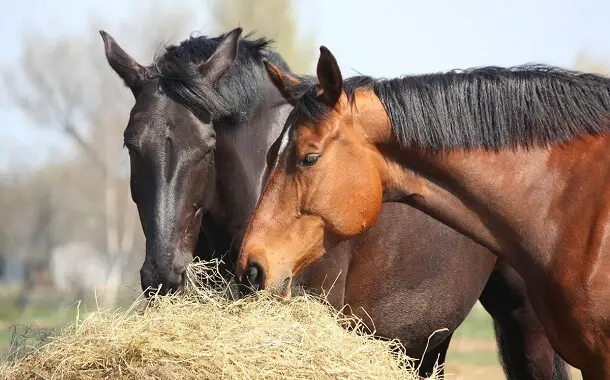How Much Does It Cost to Feed a Horse?
People who want to buy or adopt a horse will also have to consider repeated expenses like keeping and feeding it, as getting a horse is an almost life-long commitment. Experts even say that the horse isn’t the biggest expense you’ll have. It’s what comes after you get it.
It’s also pretty hard to estimate the average cost of feeding a horse, as the prices depend on the season, the region, and the size and age of the horse. This article will give you a general idea of how much it costs to feed a horse, with real-life examples.
As a general rule, the horse will consume hay and grain of about $1,620 in a year, and you will probably spend around $2,000 per year if you were to factor in pasture maintenance. Of course, these are just estimations. Let’s go into a little more detail about what feeding a horse actually means and what it costs.
How Much Does It Cost to Feed a Horse for a Year?
The cost of feeding a horse is anywhere between $1,400 and $2,000 per year, depending on factors like the season, your location, the type of horse, its size, and its age. You will spend roughly $5 to $15 per square bale for a bale of hay. Opting for grain feed for your four-legged friend will increase the expenses, but it will supplement their nutritional gains.
The University of Maine conducted a survey on 82 horse owners, having 470 horses combined, which came to about 6 hours per owner, each weighing 1,100 lbs, and concluded that they spent an average of $1,214 over a 9-month period on hay and grain. As pasture maintenance is around $200, the cost of horse food per year is around $1,400 to $2,000 per year, with an average of around $1,620 per horse. This means that the average horse will eat food worth about $150 to $170 per month.
But let’s remember that not all horses are the same, but the costs per day should be pretty easy to calculate. The specific type of hay you’re planning to give your horse will dictate the costs you’ll face.
Let’s go over several examples when owning a horse. If we assume that you have a 1,000-pound horse that needs feeding and eats about 1.5% of its body weight in forage per day, this will mean that you need roughly 15 pounds of forage per day.
| Hay Type | Price per 50 lb Bale | Feed Rate (lb/day) | Cost per lb | Cost per day | Cost per year |
|---|---|---|---|---|---|
| Grass Hay | $10 | 15 lb | $0.20 per lb | $3.00 per day | $1,095 per year |
| Mixed Grass/Legume Hay | $15 | 15 lb | $0.30 per lb | $4.50 per day | $1,642.5 per year |
| Legume Hay | $20 | 15 lb | $0.40 per lb | $6.00 per day | $2,190 per year |
You should also keep in mind that grass hays aren’t as nutritious as alfalfa or other legume hais for your horse. Thus, this type of hay usually commands a premium in price. Also, round bales tend to be cheaper than square bales, but owners usually suffer more hay lost to wastage.
You might also like our articles about the cost of a bale of hay, a bale of straw, or horse leasing.
When it comes to feed, you’d calculate costs in a pretty similar way. But feed, compared to hay, comes in a wide variety when it comes to its quality and formulation. The costs shouldn’t be the only factor you consider when you buy feed for your horse. Feeds are generally categorized as standard, high-quality, or low-quality.
In the example below, we will go over the concentrate costs related to feeding a horse of around 1,000 pounds, based on the recommendations of the feed manufacturer. As they come with higher nutrient levels, premium feeds are usually recommended to be given in smaller amounts.
Standard vs Premium Horse Feed
| Horse Feed Type | Price per 50 lb Bag | Feed Rate (lb/day) | Cost per lb | Cost per day |
|---|---|---|---|---|
| Standard Horse Feed | $14 | Maintenance (5 lb) | $0.28 per lb | $1.40 per day |
| Standard Horse Feed | $14 | Light/Moderate Exercise (10 lb) | $0.28 per lb | $2.80 per day |
| Premium Horse Feed | $20 | Maintenance (4 lb) | $0.40 per lb | $1.60 per day |
| Premium Horse Feed | $20 | Light/Moderate Exercise (8 lb) | $0.40 per lb | $3.20 per day |
 The added nutrients and benefits from premium feeds are not included in the difference of feeds.
The added nutrients and benefits from premium feeds are not included in the difference of feeds.
When you supplement standard feed with the needed nutrients, the costs will increase quite drastically. Tribune’s premium line of feeds, for example, already includes everything from minerals to vitamins and amino acids. They also have added pre and probiotics and a higher fat content, among other pros. You will have to consider the following if you want to supplement the standard feed with these nutrients to match the premium feed:
- Amino acids and other high-quality proteins will add around $1.00 per day to the final cost
- Add another $0.50 per day on pre and probiotics
- Combinations of different minerals and vitamins coupled with antioxidants will range between $0.50 and $1.50 per day
- If you also want to add fat, expect to spend between $0.50 and $1.00 per day, depending on where you get it from
Going for standard feed and then supplementing it with nutrients to save money isn’t a great approach, as you’ll spend at least $2.00 more per day, which comes to about $730 per year.
The Rule of Feeding a Horse
When you first get your first horse, you might think that it will be cheap to feed it, as they are known as “hay burners”, full vegetarians. And shouldn’t grass be free and available everywhere? Still, most adult horses will need to consume around 1.5% of their body weight per day when grazing on hay or grass. So simple math will tell you that you will need about 2.7 tons of food annually for a horse with a weight of 1,000 pounds.
You will also have to add extra calories to supplement the forage of the horse, which means additional expenses going towards equine nutrition. A pregnant mare or a growing foal, or even horses with bad teeth, geriatric problems, or metabolic syndrome, will have special needs, which means even higher expenses.
Money-Saving Tips When You Feed Your Horse
Even though you’ll have to spend a considerable amount when keeping and feeding a horse, there’s still some hope. Here are some things you can do the spend less:
- Like with most things you spend money on, buying in bulk will usually help you save. Still, make sure you have enough space to store a larger quantity of hay and that the area is protected from the weather so that you don’t spend a lot of money on hay you can’t keep in good condition.
- Find other people with horses and buy together, so that you can take advantage of the discounted rates while splitting the food.
- If you have the available land, you can consider settling down there so that the horse can access and graze the pasture. This will surely reduce the costs related to feeding it.


Leave a Reply
Want to join the discussion?Feel free to contribute!